Book and software reviews from 2007.
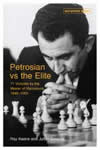 "Petrosian vs the Elite" by Ray Keene and Julian Simpole.
This book is a worthy supplement to Peter Clarke's classic "Petrosians Best
Games of Chess" filling in the gaps in that work and bringing Petrosian's career
up to date by covering 1963 when he wrestled the World Championship from
Botvinnik to his early death in 1983. The authors are (quite correctly in my
opinion) at great pains to point out how underestimated and misunderstood
Petrosian's unique style was highlighting his prowess at combinations, speed
chess and fantastic tournament successes, listing the many major events he has
won without loss of a single game. Some key game positions and a few unknown
gems against minor masters are given in the introduction but the main body of
this work are 71 victories by Petrosian against top class opposition.
Throughout, the games are nicely annotated, with an emphasis on transition to
and the middle-game itself and on endings. As many of these games can be
described as masterpieces much chess wisdom can be earned from their study-one
can only echo a frequent comment on Petrosian's style-"He makes it look so
easy". Incidently this book shows Ray Keene back in form and producing one to
match his other classic books of the 70s.
"Petrosian vs the Elite" by Ray Keene and Julian Simpole.
This book is a worthy supplement to Peter Clarke's classic "Petrosians Best
Games of Chess" filling in the gaps in that work and bringing Petrosian's career
up to date by covering 1963 when he wrestled the World Championship from
Botvinnik to his early death in 1983. The authors are (quite correctly in my
opinion) at great pains to point out how underestimated and misunderstood
Petrosian's unique style was highlighting his prowess at combinations, speed
chess and fantastic tournament successes, listing the many major events he has
won without loss of a single game. Some key game positions and a few unknown
gems against minor masters are given in the introduction but the main body of
this work are 71 victories by Petrosian against top class opposition.
Throughout, the games are nicely annotated, with an emphasis on transition to
and the middle-game itself and on endings. As many of these games can be
described as masterpieces much chess wisdom can be earned from their study-one
can only echo a frequent comment on Petrosian's style-"He makes it look so
easy". Incidently this book shows Ray Keene back in form and producing one to
match his other classic books of the 70s.
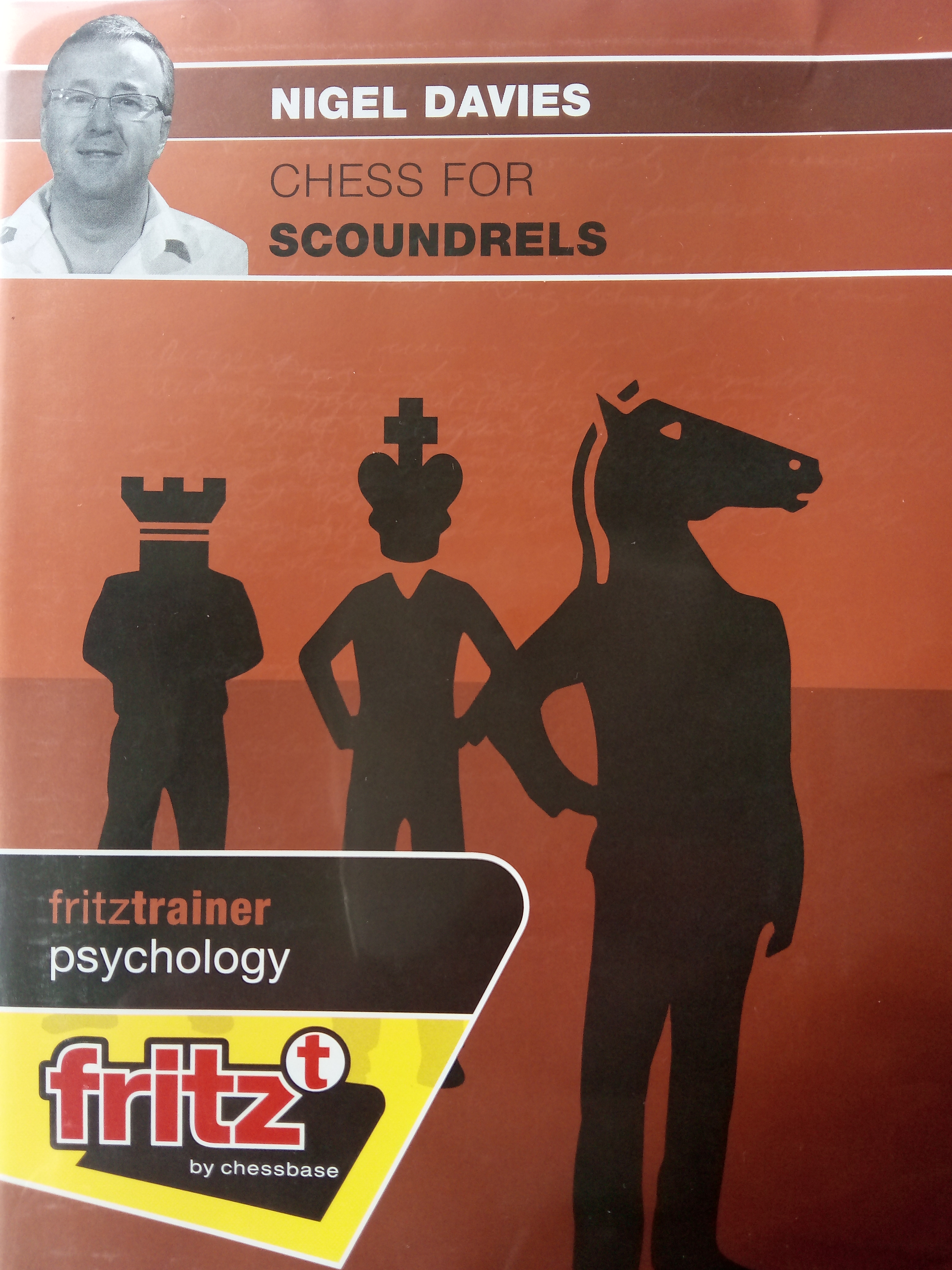 "Chess for Scoundrels" by Nigel Davies (DVD).
This DVD deals with an important feature of the game that is not adequately
covered in the chess literature nor well known enough especially at Club level.
This is a range of psychological concepts that can legitimately be utilised
during a game and which can be an important factor in achieving a win or saving
a poor game. Whilst there are quite a number of "erms", vigorous head movements
and explanations of tactical lines ended with "or something", this does not
ultimately detract from the fact this is an excellent publications. The games
are well chosen and the explanations provided, in the general introduction and
in each of the subsequent 16 chapters, are just at the right level. For the
majority of concepts covered one or more games from my own past experience
immediately came to mind. This strongly indicates it would have been a help in
knowing about these concepts before the games took place so as to aid improving
result! For each concept, apart from the explanations, very useful advise is
given in order to both adequately meet or effectively employ the concepts during
a game.
"Chess for Scoundrels" by Nigel Davies (DVD).
This DVD deals with an important feature of the game that is not adequately
covered in the chess literature nor well known enough especially at Club level.
This is a range of psychological concepts that can legitimately be utilised
during a game and which can be an important factor in achieving a win or saving
a poor game. Whilst there are quite a number of "erms", vigorous head movements
and explanations of tactical lines ended with "or something", this does not
ultimately detract from the fact this is an excellent publications. The games
are well chosen and the explanations provided, in the general introduction and
in each of the subsequent 16 chapters, are just at the right level. For the
majority of concepts covered one or more games from my own past experience
immediately came to mind. This strongly indicates it would have been a help in
knowing about these concepts before the games took place so as to aid improving
result! For each concept, apart from the explanations, very useful advise is
given in order to both adequately meet or effectively employ the concepts during
a game.
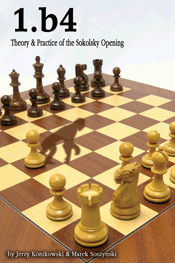 "1.b4:Theory and
Practice of the Sokolsky Opening" by Jerzy
Konikowski and Marek Sosynski.
FIDE Master Jerzy Konikowski and local player Dr. Marek Sosynski have
collaborated to produce the definitive book on the Sokolsky opening
(otherwise known as the Orangutan opening). Previously theoretical
treatments of this opening have often been quite inadequate but this book fills
a gap in opening works and is extremely well researched. The variations are very
neatly laid out, a feature that aids study, and contain much useful advice as
the games develop. In addition, the book clearly shows that 1.b4 can lead to
positions that allow for creative and original thinking. There are just under a
hundred well annotated games included in the text that nicely show the themes
and ideas of this opening. Study of this book is recommended in order to be able
to meet this opening sufficiently well in games and perhaps even to try it out
as White! Incidently there is a nice touch in the appendix in which is is
suggested serious thought be given to the endangered Orangutan-a very worth
cause.
"1.b4:Theory and
Practice of the Sokolsky Opening" by Jerzy
Konikowski and Marek Sosynski.
FIDE Master Jerzy Konikowski and local player Dr. Marek Sosynski have
collaborated to produce the definitive book on the Sokolsky opening
(otherwise known as the Orangutan opening). Previously theoretical
treatments of this opening have often been quite inadequate but this book fills
a gap in opening works and is extremely well researched. The variations are very
neatly laid out, a feature that aids study, and contain much useful advice as
the games develop. In addition, the book clearly shows that 1.b4 can lead to
positions that allow for creative and original thinking. There are just under a
hundred well annotated games included in the text that nicely show the themes
and ideas of this opening. Study of this book is recommended in order to be able
to meet this opening sufficiently well in games and perhaps even to try it out
as White! Incidently there is a nice touch in the appendix in which is is
suggested serious thought be given to the endangered Orangutan-a very worth
cause.
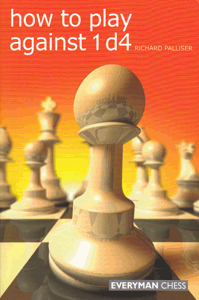 "Book
Review by Dr. Frank Eastwood "How to play against 1.d4 by Richard
Palliser (Everyman Books)". This book is reviewed because its contents
are not obvious from the title. It advocates the use of the Czech Benoni,
1.d4 Nf6 2. c4 c5 3. d5 e5, which is a neglected defence to 1.d4 and would
suit many club players, as the emphasis of the opening is based on
understanding rather than learning by rote. If you want a complete defence
to 1.d4 then the author advocates 1. d4 c5 2.d5 e5, transposing into the
Czech Benoni. The reviewer played this opening with good results in the late
sixties and it is a favourite of Mike Donnelly's. This book offers an
excellent coverage of the opening with 30 illustrative games to give the
reader an idea of tactics and strategy involved. You can play this opening
with confidence in the Coventry Chess League. Most of the players (90%) do
not have much knowledge of opening theory and would become confused with the
complicated strategy involved. This book is an excellent read and the
reviewer recommends it to the visitors of this excellent web site.
"Book
Review by Dr. Frank Eastwood "How to play against 1.d4 by Richard
Palliser (Everyman Books)". This book is reviewed because its contents
are not obvious from the title. It advocates the use of the Czech Benoni,
1.d4 Nf6 2. c4 c5 3. d5 e5, which is a neglected defence to 1.d4 and would
suit many club players, as the emphasis of the opening is based on
understanding rather than learning by rote. If you want a complete defence
to 1.d4 then the author advocates 1. d4 c5 2.d5 e5, transposing into the
Czech Benoni. The reviewer played this opening with good results in the late
sixties and it is a favourite of Mike Donnelly's. This book offers an
excellent coverage of the opening with 30 illustrative games to give the
reader an idea of tactics and strategy involved. You can play this opening
with confidence in the Coventry Chess League. Most of the players (90%) do
not have much knowledge of opening theory and would become confused with the
complicated strategy involved. This book is an excellent read and the
reviewer recommends it to the visitors of this excellent web site.
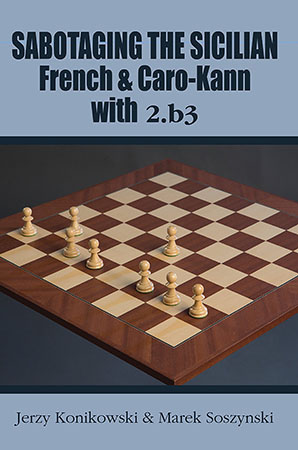 "Sabotaging
the Sicilian, French and Caro-Kann with 2.b3" by Jerzy Konikowski and Marek
Soszynski. Opening theory in recent years, aided by computer analysis, now
often extends to 20-25 or even more moves. This makes it rather difficult for
both amateur and professional players to keep up with trends and new ideas. This
especially applies to popular openings such as the KID and Grunfeld against 1.d4
and the Sicilian (s) and French against 1.e4. For the latter case the authors
have made a welcome addition to opening theory texts with the concept of playing
2. b3 against several major 1.e4 defences. This has a sound positional idea of
occupation of the centre with 1. e4 supported by playing Bb2. This way of
playing has been tried on a few occasions in the past by some of the Worlds
elite but the current book gathers together current knowledge plus some new
ideas in a clear format making study easy. This is also helped by pointed
comments throughout the various Black and White options as well as the inclusion
of many annotated illustrative games.
"Sabotaging
the Sicilian, French and Caro-Kann with 2.b3" by Jerzy Konikowski and Marek
Soszynski. Opening theory in recent years, aided by computer analysis, now
often extends to 20-25 or even more moves. This makes it rather difficult for
both amateur and professional players to keep up with trends and new ideas. This
especially applies to popular openings such as the KID and Grunfeld against 1.d4
and the Sicilian (s) and French against 1.e4. For the latter case the authors
have made a welcome addition to opening theory texts with the concept of playing
2. b3 against several major 1.e4 defences. This has a sound positional idea of
occupation of the centre with 1. e4 supported by playing Bb2. This way of
playing has been tried on a few occasions in the past by some of the Worlds
elite but the current book gathers together current knowledge plus some new
ideas in a clear format making study easy. This is also helped by pointed
comments throughout the various Black and White options as well as the inclusion
of many annotated illustrative games.
One can expect to face 2.b3, if one
defends 1.e4 with the Sicilian, French or Caro-Kann, more often in the future
thus avoidance of study of this new book could be perilous to ones results as
Black!
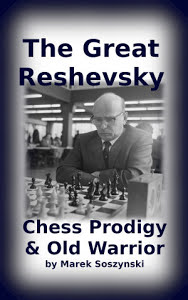 "The Great Reshevsky-Chess Prodigy&Old Warrior by Marek Soszynski" Whilst there are several books on Reshevsky's
Best Games, and many annotated
games of his in several important tournament books, there are
remarkably few details
in these about the man, his character and his life both in and out of the chess
sphere. This is an omission in the chess literature as Reshevsky was clearly one
of the top few players in the World from about the late 1930s to the 1960s.
During most of this period he was a World Championship Candidate and well before that a
more than unusually young World famous prodigy.
"The Great Reshevsky-Chess Prodigy&Old Warrior by Marek Soszynski" Whilst there are several books on Reshevsky's
Best Games, and many annotated
games of his in several important tournament books, there are
remarkably few details
in these about the man, his character and his life both in and out of the chess
sphere. This is an omission in the chess literature as Reshevsky was clearly one
of the top few players in the World from about the late 1930s to the 1960s.
During most of this period he was a World Championship Candidate and well before that a
more than unusually young World famous prodigy.
By very extensive research over many years Marek Soszynski has effectively
filled this gap in the literature. Much interesting information, as well as some
fine photographs, is provided on Reshevsky's early life, in particular relating
to his tours as a prodigy, but also
from events later in his life. There are also details on the extensive
"gamesmanship" Reshevsky employed throughout his long chess playing career.
Games are not neglected either in this book but here, in presenting some
(together with some previously unpublished games) the focus is on the personality of Reshevsky as reflected in the way the games were
conducted. The fine game annotations along with the link to Reshevsky's character adds much to
what may be learned from these games. Overall a very interesting addition to
chess literature and one that may well be a precursor for similar texts on
other neglected top players.
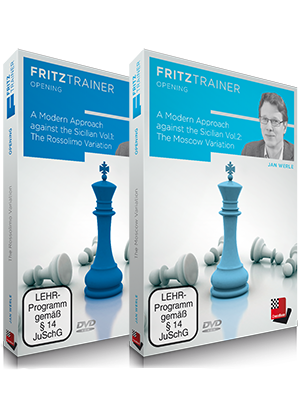 "A Modern Approach against the Sicilian" by Jan Werle.
This is a two
DVD set by GM and former lawyer Werle. The first covers the Rossolimo variation
(1. e4 c5 2.Nf3 Nc6 3.Bb5) which focuses on the so-called Modern line where
White plays 4. Bxc6, to damage Black's pawn structure, but also examines the
older line where White plays 4.0-0 with the idea of following with c3 and d4 to
dominate the centre. The second DVD cover the Moscow variation (1. e4 c5 2.Nf3
d6 3.Bb5+). Again two main lines are covered in detail in this DVD including (a)
5. 0-0 once more with the idea of a subsequent c3 and (b) 5. c4 aiming for a
Maroczy pawn structure. Less common minor lines are also detailed in each DVD.
The new DVD format means that the variations are presented in a clear and easily
accessible manner, and in contrast to a few earlier Chessbase DVDs, the language
presentation is also very smooth. The inclusion of memory test sections
and model games means these DVDs allow ready access to a very sound and solid
way of meeting the Sicilian Defence and avoiding the mountains of theory for
several of the very dynamic and often extremely complex main lines of the
Sicilian such as the Dragon or Najdorf.
"A Modern Approach against the Sicilian" by Jan Werle.
This is a two
DVD set by GM and former lawyer Werle. The first covers the Rossolimo variation
(1. e4 c5 2.Nf3 Nc6 3.Bb5) which focuses on the so-called Modern line where
White plays 4. Bxc6, to damage Black's pawn structure, but also examines the
older line where White plays 4.0-0 with the idea of following with c3 and d4 to
dominate the centre. The second DVD cover the Moscow variation (1. e4 c5 2.Nf3
d6 3.Bb5+). Again two main lines are covered in detail in this DVD including (a)
5. 0-0 once more with the idea of a subsequent c3 and (b) 5. c4 aiming for a
Maroczy pawn structure. Less common minor lines are also detailed in each DVD.
The new DVD format means that the variations are presented in a clear and easily
accessible manner, and in contrast to a few earlier Chessbase DVDs, the language
presentation is also very smooth. The inclusion of memory test sections
and model games means these DVDs allow ready access to a very sound and solid
way of meeting the Sicilian Defence and avoiding the mountains of theory for
several of the very dynamic and often extremely complex main lines of the
Sicilian such as the Dragon or Najdorf.
 "
Crushing Isolated Queens Pawn Tactics" by Robert Ris. Isolated queen's
pawns (IQP) may arise from numerous openings. They are often viewed as a weakness
since
the square in front of the pawn can frequently be blockaded, and the "weak" pawn
could be liable to be rounded up in the middle
game or especially in the ending. However, this excellent DVD shows that this
perception is only
one side of the coin. In fact there are numerous tactical plans available to the
possessor of an IQP which are often associated with a vigorous attack against
the opponent's king. Well chosen examples are offered as puzzles for the viewer
to solve. Unusually for this sort of DVD the examples are so well chosen it is
actually interesting and instructive to solve them. Should an incorrect
solution be chosen then helpful encouragement to persevere is provided with some
additional pointers on the position in question. A separate database is
also provided which feature IQP positions and interestingly shows that even
great players facing an IQP can be well beaten. All in all a worthy addition to
the chess literature.
"
Crushing Isolated Queens Pawn Tactics" by Robert Ris. Isolated queen's
pawns (IQP) may arise from numerous openings. They are often viewed as a weakness
since
the square in front of the pawn can frequently be blockaded, and the "weak" pawn
could be liable to be rounded up in the middle
game or especially in the ending. However, this excellent DVD shows that this
perception is only
one side of the coin. In fact there are numerous tactical plans available to the
possessor of an IQP which are often associated with a vigorous attack against
the opponent's king. Well chosen examples are offered as puzzles for the viewer
to solve. Unusually for this sort of DVD the examples are so well chosen it is
actually interesting and instructive to solve them. Should an incorrect
solution be chosen then helpful encouragement to persevere is provided with some
additional pointers on the position in question. A separate database is
also provided which feature IQP positions and interestingly shows that even
great players facing an IQP can be well beaten. All in all a worthy addition to
the chess literature.
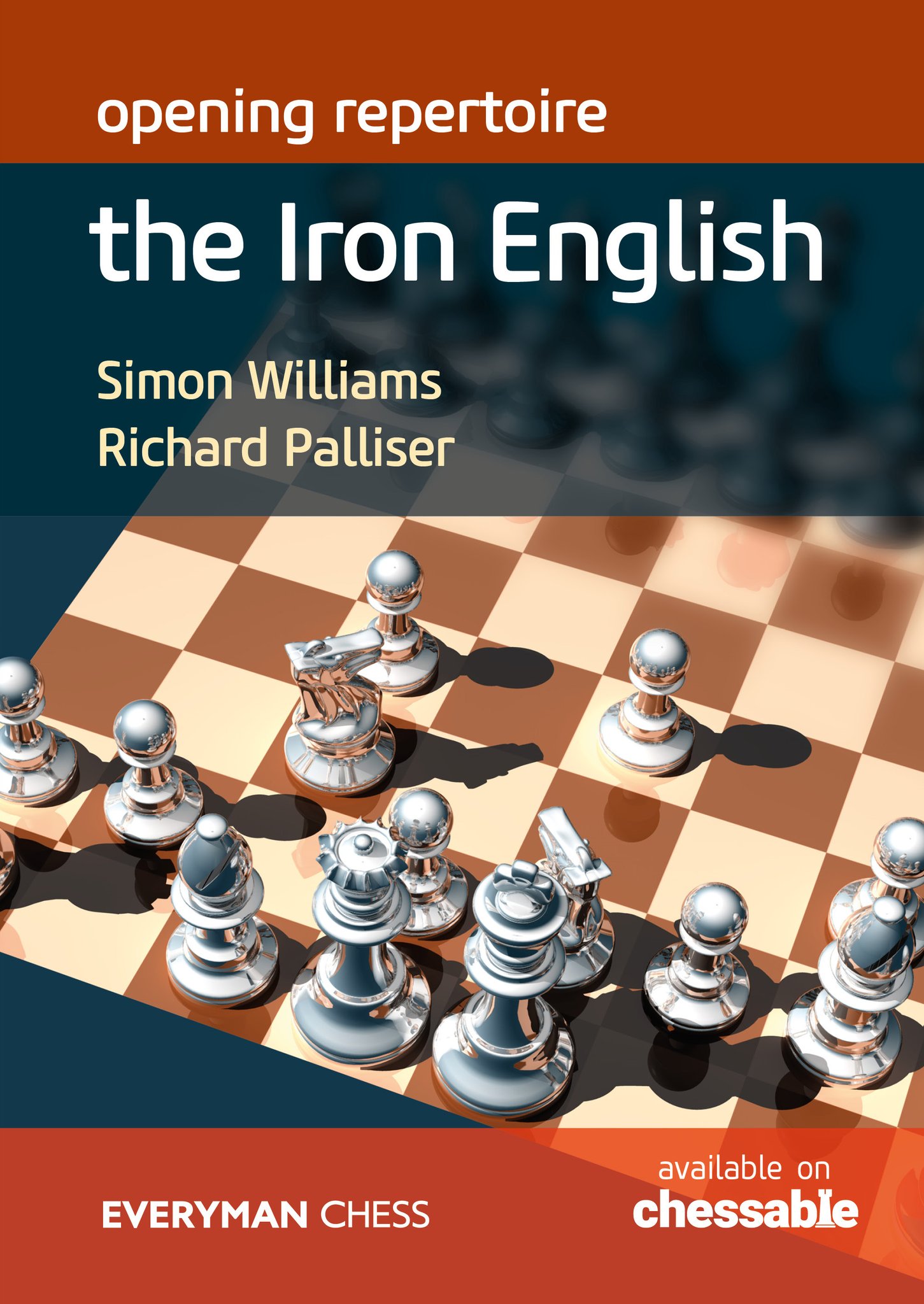 "The Iron English" Simon Williams and Richard Palliser. This book is the
essence of the sister "Iron English Course" on the revolutionary Chess improvement web
site "Chessable". It provides a nicely compact repertoire against all the major,
as well as minor, replies by Black to the English opening concentrated around
use of the Botvinnik Formation. This formation retains all the flexibility of
the English in the sense of allowing play on the kings-side, in the centre with
d4 or occupying the key square d5, as well as queens-side play via b4. The
annotations and text are very readable and neatly presented so the reader will
learn a lot about the English Opening. The book is thus far removed from those
that present very long computer generated lines with little explanation or those
that include extensive and rather unhelpful verbose comments. Highly recommended
not only as an opening text but one from which a great deal may be learned about
Chess in general. The book is available in paper format as well as electronic
format (pgn, cbv, Epub) from Everyman Chess.
"The Iron English" Simon Williams and Richard Palliser. This book is the
essence of the sister "Iron English Course" on the revolutionary Chess improvement web
site "Chessable". It provides a nicely compact repertoire against all the major,
as well as minor, replies by Black to the English opening concentrated around
use of the Botvinnik Formation. This formation retains all the flexibility of
the English in the sense of allowing play on the kings-side, in the centre with
d4 or occupying the key square d5, as well as queens-side play via b4. The
annotations and text are very readable and neatly presented so the reader will
learn a lot about the English Opening. The book is thus far removed from those
that present very long computer generated lines with little explanation or those
that include extensive and rather unhelpful verbose comments. Highly recommended
not only as an opening text but one from which a great deal may be learned about
Chess in general. The book is available in paper format as well as electronic
format (pgn, cbv, Epub) from Everyman Chess.
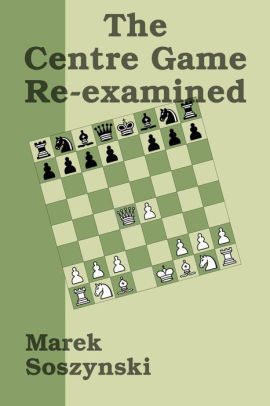 "The Centre Game Re-examined" Marek Soszynski. This is an old opening favoured by
some of the great players of the
past such as Tchigorin but has not really been systematically examined until now.
This somewhat under-estimated opening has in fact
in recent times been "discreetly"" played
now and again by the very strong GM Nepomniachtchi, even against
several other 2700+ Elo rated players, and with very decent results.
(Just after publication of the book and at the time of this review it is
interesting to note "Nepo" has just won the Candidates and qualified for a match for
the World Championship!)
"The Centre Game Re-examined" Marek Soszynski. This is an old opening favoured by
some of the great players of the
past such as Tchigorin but has not really been systematically examined until now.
This somewhat under-estimated opening has in fact
in recent times been "discreetly"" played
now and again by the very strong GM Nepomniachtchi, even against
several other 2700+ Elo rated players, and with very decent results.
(Just after publication of the book and at the time of this review it is
interesting to note "Nepo" has just won the Candidates and qualified for a match for
the World Championship!)
Thus in a very timely publication Marek analyses the various queen moves
available to White after Black plays the, almost mandatory, move 3...Nc6. Each
line leads to sharp open positions favouring the style of attacking players. Each
variation is now named and presented clearly and precisely and the book is well supported by over 20
annotated complete games. (A further indication of the timeliness of the
publication is that even Chessbase has now noted this opening and an
article has very recently appeared on their web site by IM Robert Ris).
In
E-book format the book is available from several on-line stores such as
Kindle, Apple and Barnes and Noble amongst others.
 "Petrosian vs the Elite" by Ray Keene and Julian Simpole.
This book is a worthy supplement to Peter Clarke's classic "Petrosians Best
Games of Chess" filling in the gaps in that work and bringing Petrosian's career
up to date by covering 1963 when he wrestled the World Championship from
Botvinnik to his early death in 1983. The authors are (quite correctly in my
opinion) at great pains to point out how underestimated and misunderstood
Petrosian's unique style was highlighting his prowess at combinations, speed
chess and fantastic tournament successes, listing the many major events he has
won without loss of a single game. Some key game positions and a few unknown
gems against minor masters are given in the introduction but the main body of
this work are 71 victories by Petrosian against top class opposition.
Throughout, the games are nicely annotated, with an emphasis on transition to
and the middle-game itself and on endings. As many of these games can be
described as masterpieces much chess wisdom can be earned from their study-one
can only echo a frequent comment on Petrosian's style-"He makes it look so
easy". Incidently this book shows Ray Keene back in form and producing one to
match his other classic books of the 70s.
"Petrosian vs the Elite" by Ray Keene and Julian Simpole.
This book is a worthy supplement to Peter Clarke's classic "Petrosians Best
Games of Chess" filling in the gaps in that work and bringing Petrosian's career
up to date by covering 1963 when he wrestled the World Championship from
Botvinnik to his early death in 1983. The authors are (quite correctly in my
opinion) at great pains to point out how underestimated and misunderstood
Petrosian's unique style was highlighting his prowess at combinations, speed
chess and fantastic tournament successes, listing the many major events he has
won without loss of a single game. Some key game positions and a few unknown
gems against minor masters are given in the introduction but the main body of
this work are 71 victories by Petrosian against top class opposition.
Throughout, the games are nicely annotated, with an emphasis on transition to
and the middle-game itself and on endings. As many of these games can be
described as masterpieces much chess wisdom can be earned from their study-one
can only echo a frequent comment on Petrosian's style-"He makes it look so
easy". Incidently this book shows Ray Keene back in form and producing one to
match his other classic books of the 70s. "Chess for Scoundrels" by Nigel Davies (DVD).
This DVD deals with an important feature of the game that is not adequately
covered in the chess literature nor well known enough especially at Club level.
This is a range of psychological concepts that can legitimately be utilised
during a game and which can be an important factor in achieving a win or saving
a poor game. Whilst there are quite a number of "erms", vigorous head movements
and explanations of tactical lines ended with "or something", this does not
ultimately detract from the fact this is an excellent publications. The games
are well chosen and the explanations provided, in the general introduction and
in each of the subsequent 16 chapters, are just at the right level. For the
majority of concepts covered one or more games from my own past experience
immediately came to mind. This strongly indicates it would have been a help in
knowing about these concepts before the games took place so as to aid improving
result! For each concept, apart from the explanations, very useful advise is
given in order to both adequately meet or effectively employ the concepts during
a game.
"Chess for Scoundrels" by Nigel Davies (DVD).
This DVD deals with an important feature of the game that is not adequately
covered in the chess literature nor well known enough especially at Club level.
This is a range of psychological concepts that can legitimately be utilised
during a game and which can be an important factor in achieving a win or saving
a poor game. Whilst there are quite a number of "erms", vigorous head movements
and explanations of tactical lines ended with "or something", this does not
ultimately detract from the fact this is an excellent publications. The games
are well chosen and the explanations provided, in the general introduction and
in each of the subsequent 16 chapters, are just at the right level. For the
majority of concepts covered one or more games from my own past experience
immediately came to mind. This strongly indicates it would have been a help in
knowing about these concepts before the games took place so as to aid improving
result! For each concept, apart from the explanations, very useful advise is
given in order to both adequately meet or effectively employ the concepts during
a game. "1.b4:Theory and
Practice of the Sokolsky Opening" by Jerzy
Konikowski and Marek Sosynski.
FIDE Master Jerzy Konikowski and local player Dr. Marek Sosynski have
collaborated to produce the definitive book on the Sokolsky opening
(otherwise known as the Orangutan opening). Previously theoretical
treatments of this opening have often been quite inadequate but this book fills
a gap in opening works and is extremely well researched. The variations are very
neatly laid out, a feature that aids study, and contain much useful advice as
the games develop. In addition, the book clearly shows that 1.b4 can lead to
positions that allow for creative and original thinking. There are just under a
hundred well annotated games included in the text that nicely show the themes
and ideas of this opening. Study of this book is recommended in order to be able
to meet this opening sufficiently well in games and perhaps even to try it out
as White! Incidently there is a nice touch in the appendix in which is is
suggested serious thought be given to the endangered Orangutan-a very worth
cause.
"1.b4:Theory and
Practice of the Sokolsky Opening" by Jerzy
Konikowski and Marek Sosynski.
FIDE Master Jerzy Konikowski and local player Dr. Marek Sosynski have
collaborated to produce the definitive book on the Sokolsky opening
(otherwise known as the Orangutan opening). Previously theoretical
treatments of this opening have often been quite inadequate but this book fills
a gap in opening works and is extremely well researched. The variations are very
neatly laid out, a feature that aids study, and contain much useful advice as
the games develop. In addition, the book clearly shows that 1.b4 can lead to
positions that allow for creative and original thinking. There are just under a
hundred well annotated games included in the text that nicely show the themes
and ideas of this opening. Study of this book is recommended in order to be able
to meet this opening sufficiently well in games and perhaps even to try it out
as White! Incidently there is a nice touch in the appendix in which is is
suggested serious thought be given to the endangered Orangutan-a very worth
cause.
 "Sabotaging
the Sicilian, French and Caro-Kann with 2.b3" by Jerzy Konikowski and Marek
Soszynski. Opening theory in recent years, aided by computer analysis, now
often extends to 20-25 or even more moves. This makes it rather difficult for
both amateur and professional players to keep up with trends and new ideas. This
especially applies to popular openings such as the KID and Grunfeld against 1.d4
and the Sicilian (s) and French against 1.e4. For the latter case the authors
have made a welcome addition to opening theory texts with the concept of playing
2. b3 against several major 1.e4 defences. This has a sound positional idea of
occupation of the centre with 1. e4 supported by playing Bb2. This way of
playing has been tried on a few occasions in the past by some of the Worlds
elite but the current book gathers together current knowledge plus some new
ideas in a clear format making study easy. This is also helped by pointed
comments throughout the various Black and White options as well as the inclusion
of many annotated illustrative games.
"Sabotaging
the Sicilian, French and Caro-Kann with 2.b3" by Jerzy Konikowski and Marek
Soszynski. Opening theory in recent years, aided by computer analysis, now
often extends to 20-25 or even more moves. This makes it rather difficult for
both amateur and professional players to keep up with trends and new ideas. This
especially applies to popular openings such as the KID and Grunfeld against 1.d4
and the Sicilian (s) and French against 1.e4. For the latter case the authors
have made a welcome addition to opening theory texts with the concept of playing
2. b3 against several major 1.e4 defences. This has a sound positional idea of
occupation of the centre with 1. e4 supported by playing Bb2. This way of
playing has been tried on a few occasions in the past by some of the Worlds
elite but the current book gathers together current knowledge plus some new
ideas in a clear format making study easy. This is also helped by pointed
comments throughout the various Black and White options as well as the inclusion
of many annotated illustrative games. "The Great Reshevsky-Chess Prodigy&Old Warrior by Marek Soszynski" Whilst there are several books on Reshevsky's
Best Games, and many annotated
games of his in several important tournament books, there are
remarkably few details
in these about the man, his character and his life both in and out of the chess
sphere. This is an omission in the chess literature as Reshevsky was clearly one
of the top few players in the World from about the late 1930s to the 1960s.
During most of this period he was a World Championship Candidate and well before that a
more than unusually young World famous prodigy.
"The Great Reshevsky-Chess Prodigy&Old Warrior by Marek Soszynski" Whilst there are several books on Reshevsky's
Best Games, and many annotated
games of his in several important tournament books, there are
remarkably few details
in these about the man, his character and his life both in and out of the chess
sphere. This is an omission in the chess literature as Reshevsky was clearly one
of the top few players in the World from about the late 1930s to the 1960s.
During most of this period he was a World Championship Candidate and well before that a
more than unusually young World famous prodigy.
 "A Modern Approach against the Sicilian" by Jan Werle.
This is a two
DVD set by GM and former lawyer Werle. The first covers the Rossolimo variation
(1. e4 c5 2.Nf3 Nc6 3.Bb5) which focuses on the so-called Modern line where
White plays 4. Bxc6, to damage Black's pawn structure, but also examines the
older line where White plays 4.0-0 with the idea of following with c3 and d4 to
dominate the centre. The second DVD cover the Moscow variation (1. e4 c5 2.Nf3
d6 3.Bb5+). Again two main lines are covered in detail in this DVD including (a)
5. 0-0 once more with the idea of a subsequent c3 and (b) 5. c4 aiming for a
Maroczy pawn structure. Less common minor lines are also detailed in each DVD.
The new DVD format means that the variations are presented in a clear and easily
accessible manner, and in contrast to a few earlier Chessbase DVDs, the language
presentation is also very smooth. The inclusion of memory test sections
and model games means these DVDs allow ready access to a very sound and solid
way of meeting the Sicilian Defence and avoiding the mountains of theory for
several of the very dynamic and often extremely complex main lines of the
Sicilian such as the Dragon or Najdorf.
"A Modern Approach against the Sicilian" by Jan Werle.
This is a two
DVD set by GM and former lawyer Werle. The first covers the Rossolimo variation
(1. e4 c5 2.Nf3 Nc6 3.Bb5) which focuses on the so-called Modern line where
White plays 4. Bxc6, to damage Black's pawn structure, but also examines the
older line where White plays 4.0-0 with the idea of following with c3 and d4 to
dominate the centre. The second DVD cover the Moscow variation (1. e4 c5 2.Nf3
d6 3.Bb5+). Again two main lines are covered in detail in this DVD including (a)
5. 0-0 once more with the idea of a subsequent c3 and (b) 5. c4 aiming for a
Maroczy pawn structure. Less common minor lines are also detailed in each DVD.
The new DVD format means that the variations are presented in a clear and easily
accessible manner, and in contrast to a few earlier Chessbase DVDs, the language
presentation is also very smooth. The inclusion of memory test sections
and model games means these DVDs allow ready access to a very sound and solid
way of meeting the Sicilian Defence and avoiding the mountains of theory for
several of the very dynamic and often extremely complex main lines of the
Sicilian such as the Dragon or Najdorf.
 "
Crushing Isolated Queens Pawn Tactics" by Robert Ris. Isolated queen's
pawns (IQP) may arise from numerous openings. They are often viewed as a weakness
since
the square in front of the pawn can frequently be blockaded, and the "weak" pawn
could be liable to be rounded up in the middle
game or especially in the ending. However, this excellent DVD shows that this
perception is only
one side of the coin. In fact there are numerous tactical plans available to the
possessor of an IQP which are often associated with a vigorous attack against
the opponent's king. Well chosen examples are offered as puzzles for the viewer
to solve. Unusually for this sort of DVD the examples are so well chosen it is
actually interesting and instructive to solve them. Should an incorrect
solution be chosen then helpful encouragement to persevere is provided with some
additional pointers on the position in question. A separate database is
also provided which feature IQP positions and interestingly shows that even
great players facing an IQP can be well beaten. All in all a worthy addition to
the chess literature.
"
Crushing Isolated Queens Pawn Tactics" by Robert Ris. Isolated queen's
pawns (IQP) may arise from numerous openings. They are often viewed as a weakness
since
the square in front of the pawn can frequently be blockaded, and the "weak" pawn
could be liable to be rounded up in the middle
game or especially in the ending. However, this excellent DVD shows that this
perception is only
one side of the coin. In fact there are numerous tactical plans available to the
possessor of an IQP which are often associated with a vigorous attack against
the opponent's king. Well chosen examples are offered as puzzles for the viewer
to solve. Unusually for this sort of DVD the examples are so well chosen it is
actually interesting and instructive to solve them. Should an incorrect
solution be chosen then helpful encouragement to persevere is provided with some
additional pointers on the position in question. A separate database is
also provided which feature IQP positions and interestingly shows that even
great players facing an IQP can be well beaten. All in all a worthy addition to
the chess literature.
 "The Iron English" Simon Williams and Richard Palliser. This book is the
essence of the sister "Iron English Course" on the revolutionary Chess improvement web
site "Chessable". It provides a nicely compact repertoire against all the major,
as well as minor, replies by Black to the English opening concentrated around
use of the Botvinnik Formation. This formation retains all the flexibility of
the English in the sense of allowing play on the kings-side, in the centre with
d4 or occupying the key square d5, as well as queens-side play via b4. The
annotations and text are very readable and neatly presented so the reader will
learn a lot about the English Opening. The book is thus far removed from those
that present very long computer generated lines with little explanation or those
that include extensive and rather unhelpful verbose comments. Highly recommended
not only as an opening text but one from which a great deal may be learned about
Chess in general. The book is available in paper format as well as electronic
format (pgn, cbv, Epub) from Everyman Chess.
"The Iron English" Simon Williams and Richard Palliser. This book is the
essence of the sister "Iron English Course" on the revolutionary Chess improvement web
site "Chessable". It provides a nicely compact repertoire against all the major,
as well as minor, replies by Black to the English opening concentrated around
use of the Botvinnik Formation. This formation retains all the flexibility of
the English in the sense of allowing play on the kings-side, in the centre with
d4 or occupying the key square d5, as well as queens-side play via b4. The
annotations and text are very readable and neatly presented so the reader will
learn a lot about the English Opening. The book is thus far removed from those
that present very long computer generated lines with little explanation or those
that include extensive and rather unhelpful verbose comments. Highly recommended
not only as an opening text but one from which a great deal may be learned about
Chess in general. The book is available in paper format as well as electronic
format (pgn, cbv, Epub) from Everyman Chess.
 "The Centre Game Re-examined" Marek Soszynski. This is an old opening favoured by
some of the great players of the
past such as Tchigorin but has not really been systematically examined until now.
This somewhat under-estimated opening has in fact
in recent times been "discreetly"" played
now and again by the very strong GM Nepomniachtchi, even against
several other 2700+ Elo rated players, and with very decent results.
(Just after publication of the book and at the time of this review it is
interesting to note "Nepo" has just won the Candidates and qualified for a match for
the World Championship!)
"The Centre Game Re-examined" Marek Soszynski. This is an old opening favoured by
some of the great players of the
past such as Tchigorin but has not really been systematically examined until now.
This somewhat under-estimated opening has in fact
in recent times been "discreetly"" played
now and again by the very strong GM Nepomniachtchi, even against
several other 2700+ Elo rated players, and with very decent results.
(Just after publication of the book and at the time of this review it is
interesting to note "Nepo" has just won the Candidates and qualified for a match for
the World Championship!)